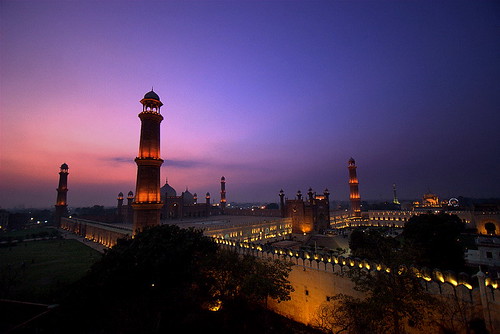I always lumped mosques in with churches from a photographic point-of-view – decent architectural subjects, which don’t particularly inspire from an aesthetic point of view unless there is an unusual cloud formation or a storm-darkened sky. From the moment I arrived at Ibn Tulun Mosque in Islamic Cairo, my opinion changed.

The most impressive aspect of this particular mosque (and I highly recommend it to anyone visiting Cairo) is the spiral minaret. This is apparently a rare feature and was inspired by the Great Mosque of Samarra in Iraq. The mud-brick quality of many of the minarets in Cairo lends the architecture a timeless and authentic quality. The Ibn Tulun minaret reminded me of illustrations I’ve seen of the Tower of Babel, the way it winds upwards like a snail’s shell.
Climbing it was an adventure in itself, especially when I got to the highest viewpoint and found myself balancing on two short, wobbly planks. But I was so captivated by the sprawling views on every side that I didn’t care.
The courtyard of Ibn Tulun is also of photographic interest. It features arches, crenellations that represent soldiers and a massive dome or fountain in the centre. The interior features a lectern from where the calls to prayer are made and the sombre atmosphere of the mosque provides a refreshing contrast with the noise and chaos of the streets outside.
It’s no surprise this mosque is one of the largest and most important in Egypt.
Next I visited the famous Mohammed Ali Mosque in the Citadel complex of Cairo. Externally, this is a visual treat, and has, more than any other mosque, come to symbolise modern Cairo. It can be seen from many different viewpoints in the city (including Ibn Tulun’s minaret) and is usually one of the first sights many visitors see.

Locals call it the ‘alabaster mosque’ because of its beautiful silver domes, which gleam in the sun – when the city is not shrouded in smog. It is a fairly recent addition, though, having been built only in the 19th century.
Despite the number of schoolchildren milling around outside the mosque when I visited, it is a relatively peaceful place from which to watch the sun go down over the Sultan Hassan Mosque, which is situated outside the Citadel walls, and which I unfortunately did not get to visit.
Close up, Mohammed Ali Mosque is indeed impressive – I would not have been able to photograph it without a wide-angle lens (10-22mm). The interior is equally impressive but the ambience is altogether more tourist-orientated than Ibn Tulun, which marred the experience slightly.
Just before I left Cairo, my taxi driver suggested I visit the Mosque of Amr ibn al-Aas near Coptic (or Christian) Cairo. This is particularly special to Muslims because it was the first place of Islamic worship in Egypt and therefore the first mosque in Africa. Actually, the original mosque is no longer standing; the current one was rebuilt on the same site.
I visited early in the morning when the smog was thick in the air. I didn’t get my best photos here but the ‘religious atmosphere’ (if there is such a thing) was far stronger than in the previous two mosques. The Koran sits on many of the benches inside and there are other holy books in piles, emphasising the mosque’s importance as a place of learning.
I was pleased I got to visit all three mosques as they were each unique and provided a rounded overall view. And I did get that shot of a minaret silhouetted against the setting sun but it simply doesn’t tell the whole story of these mighty, magical edifices.




No comments:
Post a Comment